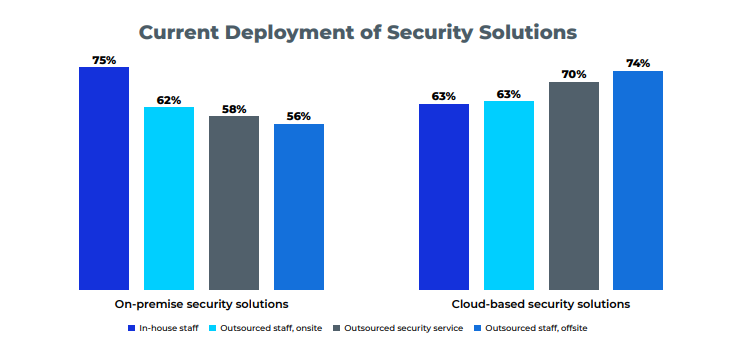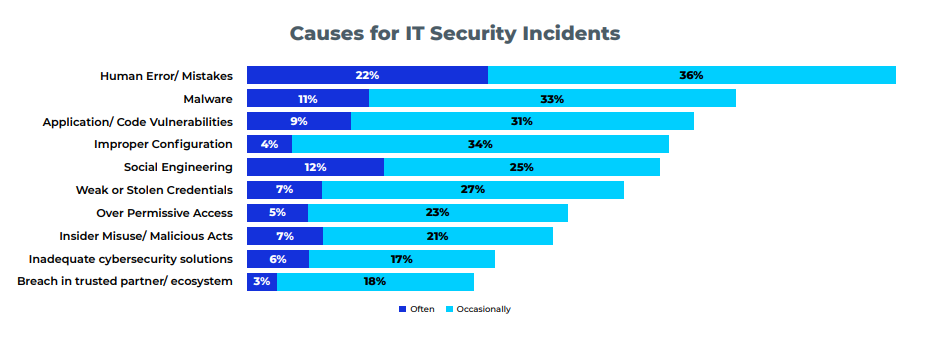- A significant majority, 75%, of on-premise cybersecurity is managed by in-house staff.
- In-house staff manage 63% of these cloud-based cybersecurity solutions.
The shift towards digitalization in Indian businesses and government sectors marks a significant step in modern development. However, this progress has also brought the issue of cybersecurity vulnerabilities to the forefront. This raises an important question: How can these organizations effectively harness the advantages of digital technology while protecting themselves against increasing cyber threats?
The rise of cyber threats
A recent State of Technology survey by CIO&Leader, paints a concerning picture of the cybersecurity threats Indian businesses face. Phishing, ransomware, and malware attacks top the list, causing operational disruptions and significant financial and reputational damage. The digitization of operations, while beneficial, has opened up new vulnerabilities that threat actors are quick to exploit.

In-house management and third-party partnerships
To combat these threats, Indian businesses are adopting a dual approach. On one side, there’s a heavy reliance on in-house staff, with 75% of businesses managing on-premise solutions and 63% handling cloud solutions internally. On the other, third-party partners play a pivotal role, offering specialized skills, advanced technology, and continuous monitoring services essential in today’s constantly evolving threat landscape.
The human factor in cybersecurity
One of the survey’s most significant findings is the human element in cybersecurity. Employees, often the weakest link, can inadvertently open doors to cyber threats through social engineering. This challenge is being met with increased education and awareness programs to fortify the first line of defense – the people.
Financial impact of cyber attacks
The financial implications of cyberattacks are stark. The global average cost of a data breach is around USD 4.35 million, a figure that can have a crippling effect on businesses. The infamous Yahoo data breach, leading to a USD 350 million valuation reduction, is a cautionary tale.
Top causes of data breaches
The survey indicates that human error, social engineering, and misconfiguration are the primary culprits behind data breaches. A notable gap in skills and understanding of cloud technologies contributes to these issues, with misconfiguration in platforms like AWS S3 and Azure Blob being all too common.

Adopting a multi-faceted defense strategy
In response, Indian businesses are implementing a range of defensive strategies. Among the key initiatives are identity and access management, security standards, and establishing Security Operations Centers. The adoption of the Zero Trust model is on the rise, signaling a shift towards more proactive defense mechanisms.
The challenge of cloud security
Cloud security presents challenges, with dependency on platform providers and a need for more experts being the primary concerns. This shortage of experts is highlighted by the 30% gap in demand and supply for cybersecurity professionals, as reported by TeamLease, a leading tech staffing firm in India.
Aligning security with business goals
A significant issue facing organizations is the need for more alignment between security and business objectives. Short-term financial goals often take precedence over necessary investments in cybersecurity, leading to outdated security infrastructures and a vulnerability to cyber threats.
Addressing the skill gap and future priorities
Organizations are focusing on retraining technical staff and engaging with external partners to combat the skill gap. Priorities for the coming months include stream
lining internal systems, implementing automated defense tools, and bolstering cybersecurity training programs.
Conclusion
As the cybersecurity landscape evolves, Indian businesses are at a critical juncture. The need for robust cybersecurity measures is more apparent than ever, requiring a balanced approach that combines technological advancements, skilled personnel, and a culture of security awareness. The path ahead is challenging, but with the right strategies and partnerships, Indian businesses can fortify their defenses against the ever-growing threat of cyberattacks.
